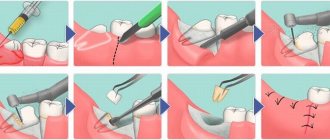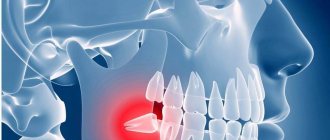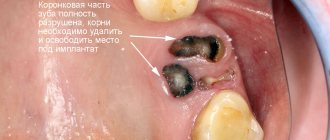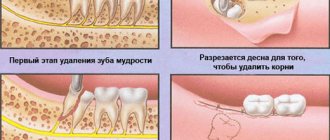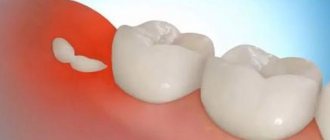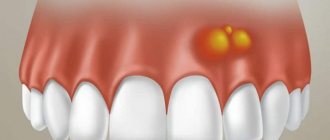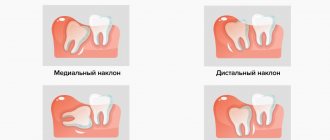31.10.2019
Today, dentists successfully treat almost any disease of the teeth and gums. Their arsenal includes advanced technologies and modern techniques that allow them to find a way out of the most difficult situations. But sometimes the only possible solution is removal - this is a drastic measure that is resorted to in desperate cases. The procedure is ordinary, and therefore complications after it occur quite rarely. It is important to contact an experienced surgeon and conscientiously follow all his recommendations in the postoperative period. Today we’ll talk about how tooth extraction in the upper jaw differs, what difficulties there may be and how the procedure is carried out.
Removal of upper teeth - what are the features?
The upper jaw has its own anatomical features. So, for example, implanting upper teeth is somewhat more difficult. The bone tissue is looser, which is why the implanted rods take several months longer to take root. Low jawbone density is due to less chewing load that falls on it. Therefore, after removal, it atrophies faster. But if implantation becomes more complicated, then with surgical extraction of teeth things are different - here the procedure is easier and simpler than on the lower jaw.
Choice of anesthesia - general or local
As noted above, the bone tissue here is less dense. It is covered by a thin membrane called the “cortical plate”. It contains a large number of openings for nerves and blood vessels. Due to this, there are no problems with the administration of local anesthesia. Removal of the upper teeth is usually easy and quick, without any discomfort. In this case, there is no need to consider general anesthesia as an alternative option for pain relief.
Risk of injury to the maxillary sinus
The maxillary sinus is located in the internal structures above the upper jaw. Often its shell is located in close proximity to the roots. If the extraction technology is violated, the sinus can be damaged, which will lead to its perforation or rupture. This complication is typical for the procedure for extracting chewing elements and wisdom teeth. It causes a number of symptoms indicating sinus injury. For example, when you eat or drink, ingested liquid and air may exit through the nose. Sometimes foam appears in the vacated hole, and during probing the instrument penetrates much deeper than it should.
This complication is a consequence of medical errors. To correct the situation, the injured membrane will have to be sutured. Sometimes perforation of the sinus leads to increased temperature, suppuration, and the development of sinusitis and sinusitis. In serious cases, the patient may be hospitalized, undergo a full-fledged operation and be prescribed a course of antibiotics.
Entry of part of the root into the sinus
Sometimes, when the maxillary sinus is damaged, part of the root penetrates into it. And this is again a medical error caused by incorrect advancement of the tooth at the time of its extraction. Often such a complication occurs against the background of thinning of the bone plate. Simply put, the tooth breaks and part of its root system “slips” into the sinus.
Among the characteristic symptoms, dental experts identify fluid and air entering the nose through the mouth, severe runny nose, high temperature, and pain in the nose. To clarify the diagnosis, the patient is sent for an X-ray examination. Next, he is prescribed a full-fledged operation, which is carried out in a hospital setting.
Types of anesthesia
When a molar needs to be removed, anesthesia should be performed. There are three anesthesia options for this:
- local. Is it painful to have a wisdom tooth removed with this type of anesthesia? It is used most often. It acts in a specific area and relieves nerve endings of sensitivity;
- general anesthesia. Sometimes the patient does not have enough local anesthesia. Then anesthesia is used if the patient suffers from mental disorders, is terrified of surgery, and has a gag reflex. With such anesthesia, a person simply falls asleep;
- combined. Here, medications that promote relaxation and local anesthesia are simultaneously used. The patient remains conscious, but his emotional and physical levels decrease.
Is it painful to have a wisdom tooth removed? With high-quality anesthesia, you will not feel anything.
How painful is it to remove upper teeth?
Today dentistry has all the capabilities to treat any complexity without pain and discomfort for patients. Even complex removal of the posterior destroyed element, including the figure eight, can be carried out quickly and completely painlessly. When working on the upper jaw, local anesthesia is usually sufficient. If desired, the patient can insist on the use of general anesthesia, for example, if he has a panic fear of dental treatment. Here you need to understand that the use of such powerful anesthesia has a whole list of contraindications and requires serious preparation.
An excellent alternative can be sedation, which involves placing the patient in a semi-conscious state. Fear and anxiety disappear, the person feels completely calm and relaxed, and can respond to simple requests from the doctor. It is noteworthy that after the sedation ends, the patient may not remember how the procedure took place. It should be understood that sedation is only an addition to pain relief and does not exclude the use of local anesthetics.
How painful is the surgery?
The use of modern equipment and special surgical equipment makes the task of removal easier for both the doctor and the patient. Painful sensations are eliminated by anesthesia. The injection is made by the dentist into the gum area. The injection itself is almost imperceptible and does not cause discomfort.
Wisdom tooth extraction can be sensitive for patients who have been taking pain medications for a long time. For particularly sensitive people, it is suggested to use either a repeat injection or a stronger anesthetic. More pronounced sensations can be observed in isolated cases in patients with an advanced abscess.
Painless surgery - complex or simple - is already a reality. The specialists of the Zuub clinic, thanks to the use of modern equipment and their accumulated experience, carry out operations efficiently and quickly. In such conditions, the patient can not only count on the absence of pain, but also complete comfort during removal.
Contraindications to the procedure
The extraction procedure (that’s what it’s officially called) has its limitations. It should be noted that almost all contraindications are relative, which means that after eliminating limiting factors, removal can be carried out. These phenomena and conditions include the following:
- acute infectious diseases,
- blood clotting disorders,
- first and last trimester of pregnancy,
- 2 days before and after menstruation,
- diabetes in an uncompensated stage,
- pathologies of the heart and blood vessels,
- mental illnesses in aggravation.
Sometimes emergency removal is required, and then there is simply no time left to eliminate the above-mentioned obstacles. In this case, the doctor takes on additional risk and performs the procedure as carefully as possible. It is better if it is a truly experienced and qualified dental surgeon.
Description of the procedure: how it is carried out
If the patient is undergoing a planned operation, then first he is sent for an X-ray examination and tests. After studying the diagnostic results, the doctor begins the procedure or prescribes it for the next free time. Complex extraction is recommended to be carried out at the beginning of the day. It is better not to eat or drink immediately before visiting the doctor - this will help enhance the effect of the anesthetic. If the patient suddenly catches a cold before removal, it is better to reschedule the procedure.
First, the specialist administers anesthesia. If a simple operation is to be performed, its duration will be no more than 20 minutes. Using special forceps, the doctor carefully clamps the crown, rocks it with a special movement, and then sharply pulls it out of the socket. Lightly compresses the edges of the wound until the hole is completely filled with blood and a blood clot is formed - protection against infection and mechanical damage. Next, the doctor treats the injured tissue with an antiseptic, prescribes painkillers, and in some cases antibiotics, and gives detailed instructions about the postoperative period.
Difference between simple and complex type
- Simple baby tooth extraction can be performed without anesthesia. Removal of the complex must be carried out after anesthesia.
- Duration. The simple procedure usually lasts from five to fifteen minutes. A complex surgical intervention can last from twenty minutes to an hour, and sometimes even take place in more than one stage.
- A simple tooth is removed with forceps and an elevator. The complex procedure requires special tools that may be needed to cut, lift the tooth, or saw through the root.
- After complex surgery, you may need to take antibiotics and anti-inflammatory drugs.
Difficult removal of a wisdom tooth (eight) - what are the features?
Complex removal usually concerns teeth with a branched root system, impacted, dystopic, destroyed elements, and figure eights. In this case, the procedure looks like this:
- the specialist makes an incision on the gum, peels off a flap of the mucous membrane,
- if the tooth is located under a layer of bone tissue, it is literally cut out using a special bur,
- then the element is carefully removed in parts, for which special forceps are used,
- the doctor cleans the hole and treats the tissue with an antiseptic,
- the resulting cavity is filled with osteo-replacing material and covered with a protective membrane to prevent the growth of the mucosa,
- the wound is tightly sutured.
The procedure can last 40-60 minutes. A few days later, the patient is invited to a second visit so that the specialist can assess how successful the healing process is.
Possible complications
Complications are more typical for cases of complex removal. And even with the extraction of a wisdom tooth, if the operation is performed on the upper jaw, the risk of developing undesirable consequences remains minimal. A dangerous complication after removal is alveolitis - inflammation of the socket with possible suppuration. The mucous membrane in the area of the defect turns somewhat red, swelling appears, the blood clot disappears, and instead a yellowish coating with an unpleasant odor appears. There may be discharge of pus and increased body temperature.
Important! When answering the question about how long it takes for a wound to heal after removal, it should be noted that pain and swelling usually go away within 3-4 days. If during this time the pain only intensifies, consult a doctor immediately.
Another possible complication could be injury or perforation of the nasal sinus, or penetration of part of the root into it. Typically, this situation occurs due to the fault of the doctor if he pressed too hard on the instrument. To avoid such troubles, it is important to take the choice of a clinic and doctor seriously, as well as follow all the specialist’s recommendations after the procedure until the tissues are completely restored.
Removal methods
There are two main types of extirpation - a simple removal method and a complex method.
Complex removal method
It is carried out in cases where there is no access to the tooth, application of forceps is impossible and additional access must be made through an incision in the gums. During a complex operation, the tooth is not removed immediately, but in parts.
For this, a whole set of special tools is used:
- laser,
- saw,
- scalpel,
- burs.
Complex removal may be indicated in the case of a cystic formation under the causative tooth, fistula, dystopic wisdom tooth, or retention. Contraindications to the procedure are pregnancy, allergies to anesthetic drugs, mental illness, problems with the endocrine system. But if certain conditions are created, extirpation can be carried out even in the presence of these contraindications.
Simple operation
This method does not require additional preparation; it is removed by applying standard forceps, after which the bleeding stops and further measures are taken to restore the dentition.
Is it possible to perform prosthetics immediately after root removal?
Single-stage implantation is a technology that allows you to restore a tooth immediately after its extraction. This technique makes it possible to significantly reduce treatment and restore the aesthetics and functionality of your smile in the shortest possible time. This concept includes immediate loading protocols, but in some cases a classic implant is fixed using standard two-stage technology.
However, today experts prefer one-stage methods. According to the results of numerous clinical studies, implantation using a one-stage technology immediately after tooth extraction protects bone tissue from atrophy and reduces treatment time with a guarantee of long-term results of up to 96%1.
“I needed to remove one decayed tooth, but the problem was that it was in sight. I wanted to do everything right, but I was very worried that I would have to walk around with a hole while the implant took root. And then I came to you, and they offered me a one-step implantation. The tooth was carefully removed and an implant with a crown was immediately placed in its place. The procedure went quickly, completely without pain, although I still had doubts about local anesthesia and thought about going under anesthesia. I am immensely grateful to your specialists!”
Lyubov Vyacheslavovna K., 46 years old, review on the website of a Moscow dental clinic
After extraction, restoration of bone tissue is not required - the implant is implanted into the vacated socket and can be additionally strengthened with bone replacement powder. In this case, a temporary crown is immediately fixed, and after a few months, when the implant has fused with the jawbone, it is replaced with a permanent single prosthesis. A temporary crown is created from a lightweight material – plastic. It turns out to be slightly shorter than the neighboring elements, which avoids intense mechanical impact and displacement of the artificial root.
Important! Single structures are fixed only in place of single-rooted front teeth (incisors and canines), which are not subject to intense exposure. Their main function is to restore the aesthetics of the row.
But this procedure is not possible in all cases. Implantation is a serious operation that cannot be performed without careful preparation. It is necessary to study the clinical picture, exclude possible contraindications, and select an implant model. Most patients turn to dentistry when emergency removal is required, and there is simply no time left for preparation.
Estimated cost of the procedure
According to the compulsory medical insurance policy, a tooth can be removed completely free of charge, in a state clinic. In private clinics, the procedure will cost from 1,500 to 3,000 rubles, depending on the degree of complexity. In some situations, the cost of the operation can even reach 15 thousand rubles or more, for example, with a complex extraction of the figure eight using sedation.
As for immediate recovery, the cost of such treatment using inexpensive brands will cost approximately 30-50 thousand rubles - this includes x-ray diagnostics, 3D planning and tests. Restoration with the installation of a more expensive Nobel Biocare implant and an adaptation crown will cost approximately 70-90 thousand rubles.
Category: Tooth extraction Published by Mister stomatolog


